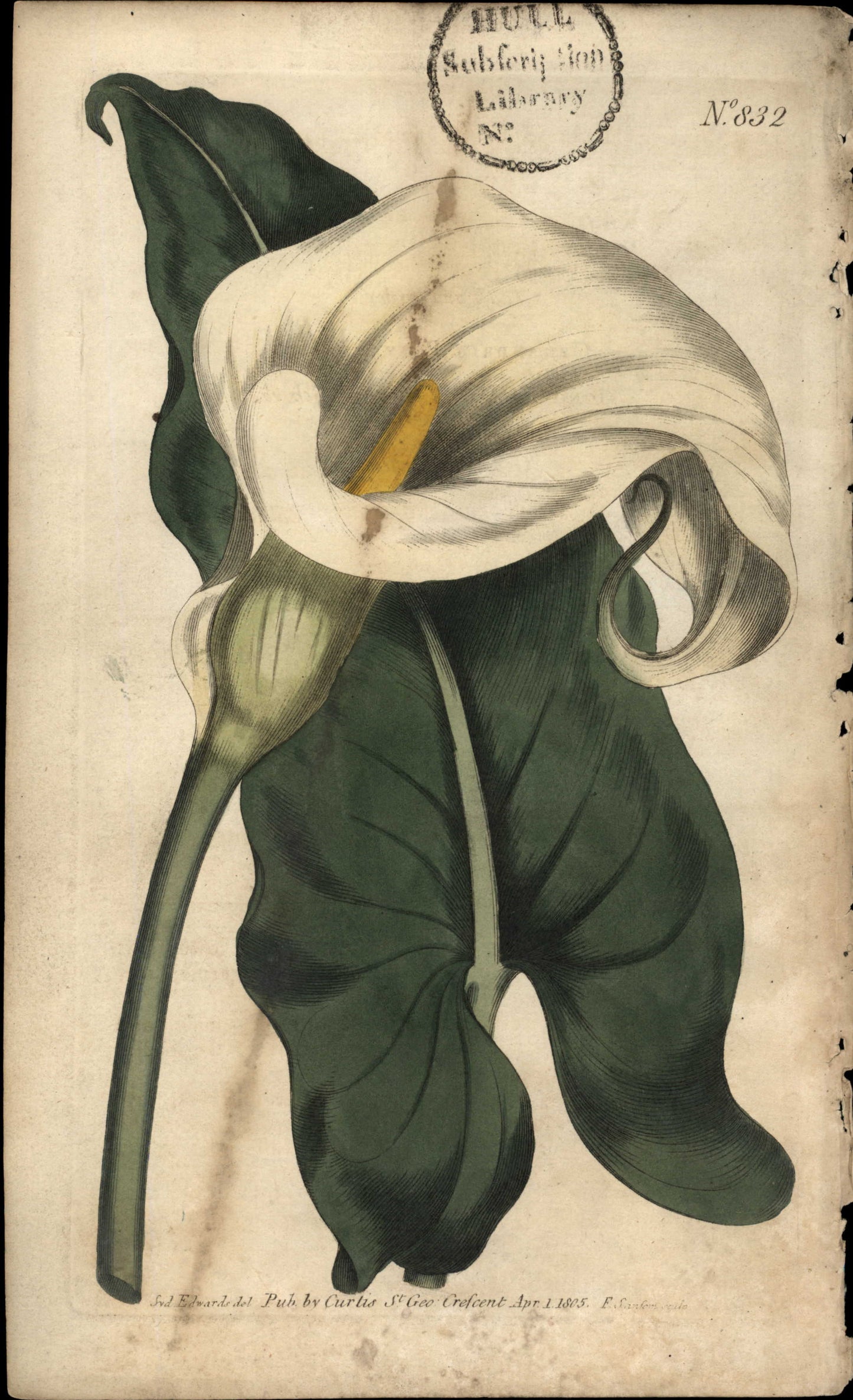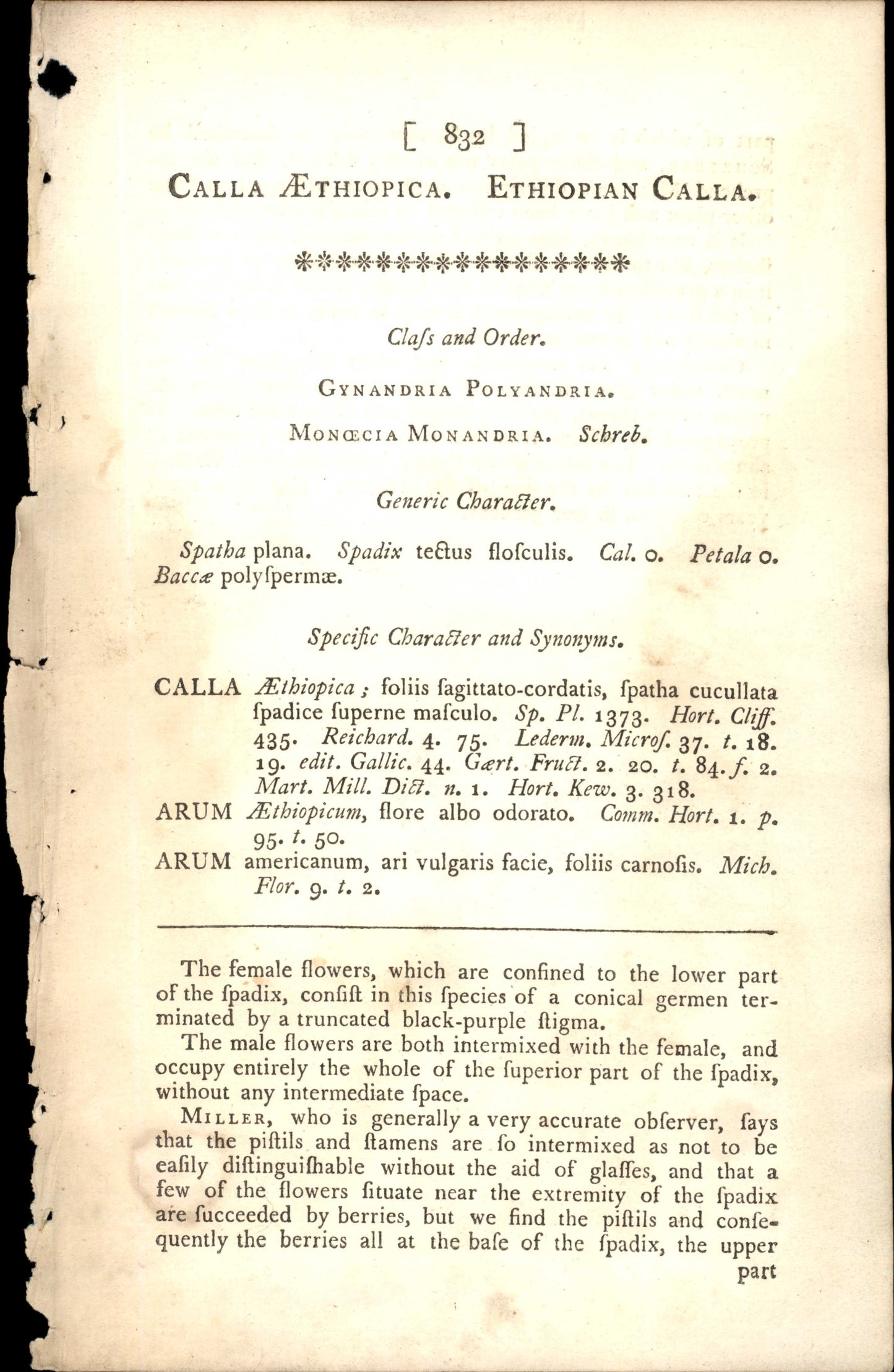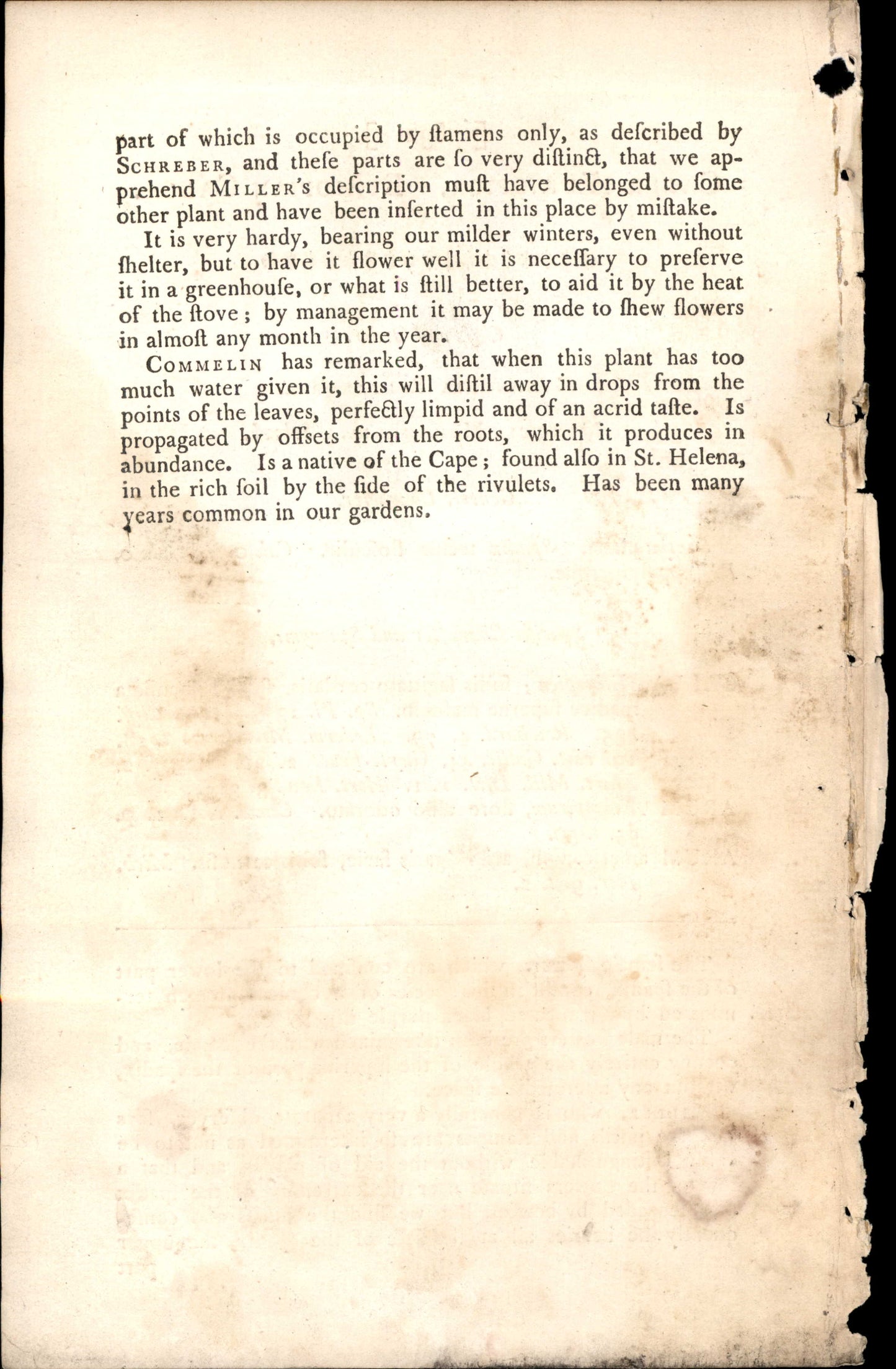Curtis Botanical Magazine
Plate 832 - Ethiopian Calla
Plate 832 - Ethiopian Calla
Couldn't load pickup availability
Plate 832
Classification: GYNANDRIA POLYANDRIA
Flowering Period: May
Publication Date: Apr 1.1805
Description:
Complete Botanical Text (Cleaned)
HULL subferi tion Library N: svd Edwards del Pub by Curtis st Geo Crefcent Apr 1.1805.
Fanele N°832 [ 832 ] CALLA ETHIOPICA.
ETHIOPIAN CALLA. **** Class and Order.
GYNANDRIA POLYANDRIA.
MONCCIA MONANDRIA.
Generic Character. schreb. spatha plana. spadix tectus flofculis.
Cal. o.
Bacce polyspermæ. specific Character and synonyms.
Petala o.
CALLA Ethiopica; foliis fagittato-cordatis, spatha cucullata fpadice superne mafculo. sp.
Pl. 1373.
Hort.
Cliff. 435.
Reichard. 4. 75.
Lederm.
Microf. 37. t. 18. 19. edit.
Gallic. 44.
Gært.
Fruct. 2. 20. t. 84. f. 2.
Mart.
Mill.
Dict. n. 1.
Hort.
Kew. 3. 318.
ARUM Æthiopicum, flore albo odorato.
Comm.
Hort. 1. p. 95. t. 50.
ARUM americanum, ari vulgaris facie, foliis carnofis.
Mich.
Flor. 9. t. 2.
The female flowers, which are confined to the lower part of the fpadix, confift in this species of a conical germen ter- minated by a truncated black-purple stigma.
The male flowers are both intermixed with the female, and occupy entirely the whole of the superior part of the fpadix, without any intermediate space.
MILLER, who is generally a very accurate obferver, fays that the piftils and stamens are fo intermixed as not to be eafily diftinguifhable without the aid of glaffes, and that a few of the flowers fituate near the extremity of the spadix are succeeded by berries, but we find the piftils and confe- quently the berries all at the base of the spadix, the upper part part of which is occupied by stamens only, as described by sCHREBER, and these parts are fo very distinct, that we ap- prehend MILLER'S defcription muft have belonged to some other plant and have been inserted in this place by mistake.
It is very hardy, bearing our milder winters, even without shelter, but to have it flower well it is neceffary to preferve it in a greenhoufe, or what is ftill better, to aid it by the heat of the ftove; by management it may be made to shew flowers in almost any month in the year.
Is COMMELIN has remarked, that when this plant has too much water given it, this will diftil away in drops from the points of the leaves, perfectly limpid and of an acrid tafte. propagated by offsets from the roots, which it produces in abundance.
Is a native of the Cape; found also in st.
Helena, in the rich foil by the fide of the rivulets.
Has been many years common in our gardens
Raw OCR Text (Original)
HULL subferi tion Library N: svd Edwards del Pub by Curtis st Geo Crefcent Apr 1.1805. Fanele N°832 [ 832 ] CALLA ETHIOPICA. ETHIOPIAN CALLA. **** Class and Order. GYNANDRIA POLYANDRIA. MONCCIA MONANDRIA. Generic Character. schreb. spatha plana. spadix tectus flofculis. Cal. o. Bacce polyspermæ. specific Character and synonyms. Petala o. CALLA Ethiopica; foliis fagittato-cordatis, spatha cucullata fpadice superne mafculo. sp. Pl. 1373. Hort. Cliff. 435. Reichard. 4. 75. Lederm. Microf. 37. t. 18. 19. edit. Gallic. 44. Gært. Fruct. 2. 20. t. 84. f. 2. Mart. Mill. Dict. n. 1. Hort. Kew. 3. 318. ARUM Æthiopicum, flore albo odorato. Comm. Hort. 1. p. 95. t. 50. ARUM americanum, ari vulgaris facie, foliis carnofis. Mich. Flor. 9. t. 2. The female flowers, which are confined to the lower part of the fpadix, confift in this species of a conical germen ter- minated by a truncated black-purple stigma. The male flowers are both intermixed with the female, and occupy entirely the whole of the superior part of the fpadix, without any intermediate space. MILLER, who is generally a very accurate obferver, fays that the piftils and stamens are fo intermixed as not to be eafily diftinguifhable without the aid of glaffes, and that a few of the flowers fituate near the extremity of the spadix are succeeded by berries, but we find the piftils and confe- quently the berries all at the base of the spadix, the upper part part of which is occupied by stamens only, as described by sCHREBER, and these parts are fo very distinct, that we ap- prehend MILLER'S defcription muft have belonged to some other plant and have been inserted in this place by mistake. It is very hardy, bearing our milder winters, even without shelter, but to have it flower well it is neceffary to preferve it in a greenhoufe, or what is ftill better, to aid it by the heat of the ftove; by management it may be made to shew flowers in almost any month in the year. Is COMMELIN has remarked, that when this plant has too much water given it, this will diftil away in drops from the points of the leaves, perfectly limpid and of an acrid tafte. propagated by offsets from the roots, which it produces in abundance. Is a native of the Cape; found also in st. Helena, in the rich foil by the fide of the rivulets. Has been many years common in our gardens.
Original botanical print from Curtis's Botanical Magazine
Share







